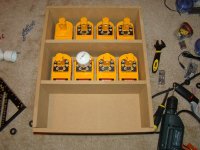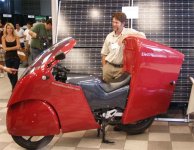EVBiker2000
100 W
The LIPO batteries and I did not get along, so we divorced. Among other things, what really gets me is that most of the rechargeable battery technology out there is just plain hard to get. Hobbyking does seem to reign supreme but I just don't like having to order LIPOs from the web. You get the order after about 2 weeks, and then find out that it was damaged in shipping, or it's defective, or, etc. etc. So I wanted to come up with a way that I would not have to worry about this hassle. I wanted rechargeables that are easy to get, i.e. LOCAL, and cheap enough that it didn't cause me a divorce and broken family.  I love the 36Volt Lithium Nano Phosphates from DeWalt, but good golly molly, it scares me to have to work for months to save up for these, and then what if I screw one up??? I think I would literally crawl into a fetal position and begin bawling like a baby.
I love the 36Volt Lithium Nano Phosphates from DeWalt, but good golly molly, it scares me to have to work for months to save up for these, and then what if I screw one up??? I think I would literally crawl into a fetal position and begin bawling like a baby.
So, I spent about 20 some odd hours reading about rechargeables. After reading some excellent sites, (one of which I'll post below), I have come to realize that all rechargeables have some weirdnesses about them. If batteries and I are going to get along, I need to learn the proper care and feeding of the battery I chose. After much internal debate, walking around the neighborhood, chewing on dry pieces of straw, a few root beers, I've decided to go back to ANCIENT TECHNOLOGY. I have decided to choose NiCads.
Let the flame wars begin! :lol:
After much reading, I realize now why NiCads were such a failure in the mass consumer market. I surely wasn't told all the information about "exercising" and "conditioning" NiCads, and I'm sure most of you were not either. Among other things, isn't it amazing how guys take their NiCads and LEAVE THEM ON THE CHARGER?!?!? The absolute WORST thing possible to do with a NiCad. The "Dendrite" cystals LOVE that type of environment and grow like crazy. I think for the most part, NiCads and electric bikes can be a great fit. You put the NiCads on a charger, when the charging process is done, you take them off and ride. Absolutely no charging up the NiCads and then allowing them to sit around for days/weeks on end. Not only would that shorten the NiCad life, but NiCads rapidly lose a good chunk of their charge each day anyway.
For me, my electric bike is to be my 2nd Vehicle. I don't want or need something I have to fiddle with everyday. If a battery pack goes bad, I don't want to wait 2 weeks for a new one from Hong Kong. Or if I screw up, I want to be able to walk over to a local store and buy a replacement. I'm going for simplicity now.
So here it is.....the Ryobi One+ Electric Bike Build.

I chose the 18V Ryobi One+ battery (Model P100) for several reasons. One reason is it is readily available at Home Depot centers around the country. Also, it is pushed heavily by Home Depot who sells a 2 pack for $50. They are 1.7 AmpHr NiCads (15s1p configuration). That is about 30.6W Hours per battery. I'm going for 28 of these for a total of 28*30.6= 857 Watt Hours. They will be wired as 4s7p, or 72Volt, 11.9 AmpHr.
Another reason for choosing the Ryobi One+ is because at some point in the future, if I am not happy with the Model P100, I can easily upgrade to the P104 model (Lithion Ion, 2.4 Amp Hour). The foot print is the same as the P100 model. (There is also a P103 model as well).
I am creating a crude but effective Ryobi battery connector out of 1.25 inch PVC end-caps and some 8-32x1 Brass Flathead screws. By tweaking the distance of the screws, I'm able to create an extremely well fitting connector. I'm also adding a tap to the thermistor connector. Using the temperature is really not the best way to monitor the NiCad charging process. I plan on using the Voltage Delta method, but I'm going to keep the temperature/thermistor connection because I think it provides an extra reading of the charging process....just in case the temp gets out of hand, my charger can shutdown the charging process.
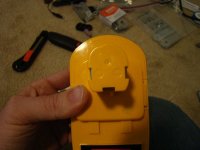
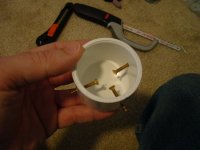
In this photo, holes are drilled in the end-cap. A machine screw will hold the end-cap to the back wall of the battery box.
View attachment 2
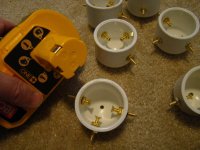
Once the connector is on, it takes about 20-25 lbs of pull force to get it off. A really nice snug fit, probably much better than the connection in a cordless drill.
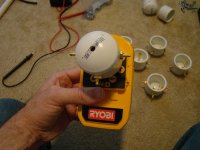
So, I spent about 20 some odd hours reading about rechargeables. After reading some excellent sites, (one of which I'll post below), I have come to realize that all rechargeables have some weirdnesses about them. If batteries and I are going to get along, I need to learn the proper care and feeding of the battery I chose. After much internal debate, walking around the neighborhood, chewing on dry pieces of straw, a few root beers, I've decided to go back to ANCIENT TECHNOLOGY. I have decided to choose NiCads.
Let the flame wars begin! :lol:
After much reading, I realize now why NiCads were such a failure in the mass consumer market. I surely wasn't told all the information about "exercising" and "conditioning" NiCads, and I'm sure most of you were not either. Among other things, isn't it amazing how guys take their NiCads and LEAVE THEM ON THE CHARGER?!?!? The absolute WORST thing possible to do with a NiCad. The "Dendrite" cystals LOVE that type of environment and grow like crazy. I think for the most part, NiCads and electric bikes can be a great fit. You put the NiCads on a charger, when the charging process is done, you take them off and ride. Absolutely no charging up the NiCads and then allowing them to sit around for days/weeks on end. Not only would that shorten the NiCad life, but NiCads rapidly lose a good chunk of their charge each day anyway.
For me, my electric bike is to be my 2nd Vehicle. I don't want or need something I have to fiddle with everyday. If a battery pack goes bad, I don't want to wait 2 weeks for a new one from Hong Kong. Or if I screw up, I want to be able to walk over to a local store and buy a replacement. I'm going for simplicity now.
So here it is.....the Ryobi One+ Electric Bike Build.

I chose the 18V Ryobi One+ battery (Model P100) for several reasons. One reason is it is readily available at Home Depot centers around the country. Also, it is pushed heavily by Home Depot who sells a 2 pack for $50. They are 1.7 AmpHr NiCads (15s1p configuration). That is about 30.6W Hours per battery. I'm going for 28 of these for a total of 28*30.6= 857 Watt Hours. They will be wired as 4s7p, or 72Volt, 11.9 AmpHr.
Another reason for choosing the Ryobi One+ is because at some point in the future, if I am not happy with the Model P100, I can easily upgrade to the P104 model (Lithion Ion, 2.4 Amp Hour). The foot print is the same as the P100 model. (There is also a P103 model as well).
I am creating a crude but effective Ryobi battery connector out of 1.25 inch PVC end-caps and some 8-32x1 Brass Flathead screws. By tweaking the distance of the screws, I'm able to create an extremely well fitting connector. I'm also adding a tap to the thermistor connector. Using the temperature is really not the best way to monitor the NiCad charging process. I plan on using the Voltage Delta method, but I'm going to keep the temperature/thermistor connection because I think it provides an extra reading of the charging process....just in case the temp gets out of hand, my charger can shutdown the charging process.


In this photo, holes are drilled in the end-cap. A machine screw will hold the end-cap to the back wall of the battery box.
View attachment 2

Once the connector is on, it takes about 20-25 lbs of pull force to get it off. A really nice snug fit, probably much better than the connection in a cordless drill.









